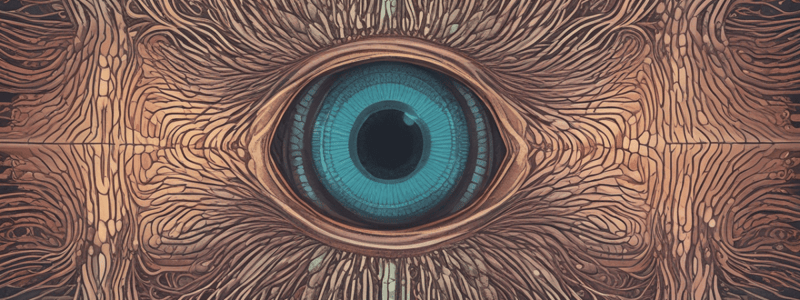Podcast
Questions and Answers
Which part of the retina is responsible for the most detailed vision?
Which part of the retina is responsible for the most detailed vision?
- Peripheral retina
- Optic nerve
- Blind spot
- Macula lutea (correct)
What is the primary function of rods in the retina?
What is the primary function of rods in the retina?
- Daylight vision
- Color recognition
- Central vision
- Night vision (correct)
At what angle from the visual axis is the maximum density of rods found?
At what angle from the visual axis is the maximum density of rods found?
- 13º
- 18º
- 20º (correct)
- 0º
How many cones are there approximately in each eye?
How many cones are there approximately in each eye?
What type of cells, besides photoreceptors, are found in the retina?
What type of cells, besides photoreceptors, are found in the retina?
Which cells in the retina are most sensitive to blue-green light (~510 nm)?
Which cells in the retina are most sensitive to blue-green light (~510 nm)?
How long do cones take to adapt to darkness?
How long do cones take to adapt to darkness?
Why is the region from about 13º to 18º called a blind spot?
Why is the region from about 13º to 18º called a blind spot?
Flashcards are hidden until you start studying
Study Notes
Image Formation on the Retina
- The retina converts light images into electrical nerve impulses that are sent to the brain.
- The absorption of a light photon in a photoreceptor initiates a photochemical reaction, which produces electrical nerve impulses.
- Most vision is restricted to the macula lutea, or yellow spot, which is a small area of the retina.
- All detailed vision takes place in the fovea centralis, a very small area (0.3mm in diameter) within the yellow spot.
Photoreceptors in the Retina
- There are two general types of photoreceptors: cones and rods.
- The rods and cones are distributed symmetrically in all directions from the visual axis, except in the blind spot.
- The blind spot has neither rods nor cones and is located from about 13º to 18º from the visual axis.
Characteristics of Rods
- There are 120 million rods in each eye.
- They are used for night vision and peripheral vision.
- They cover most of the retina, with maximum density at an angle of about 20º from the vision axis.
- Hundreds of rods send their information to the same nerve fiber.
- They have poor ability to resolve two close sources of light.
- They are most sensitive to blue-green light (~510nm).
- They continue to dark adapt for 30 to 60 minutes.
Characteristics of Cones
- There are 6.5 million cones in each eye.
- They are used for daylight vision, where we see fine details and recognize different colors.
- They are primarily found in the fovea centralis.
- Each cone has its own nervous link to the brain.
- Their density determines the amount of details we can resolve in the eye.
- They have a maximum sensitivity at about 550 nm in the yellow-green region.
- They are most rapid in dark adaptation (5 minutes).
Studying That Suits You
Use AI to generate personalized quizzes and flashcards to suit your learning preferences.




